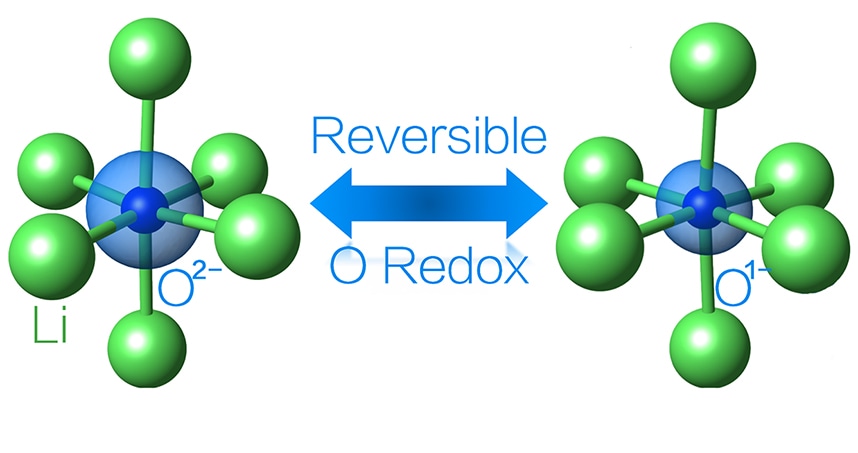Jan 4 2018
Theoretically, it seems as though Christopher Wolverton’s super lithium-rich battery shouldn't work. For one, the novel battery makes use of iron, which is notorious for failing in batteries. Additionally, the battery leverages oxygen in order to help drive the chemical reaction, which researchers originally believed would lead to the battery becoming unstable. However, it has lead to a higher capacity battery that works exceptionally well.
 Photo credit: Northwestern University
Photo credit: Northwestern University
Collaborating with researchers at Argonne National Laboratory, Wolverton’s group succeeded in developing a rechargeable lithium-iron-oxide battery capable of cycling more lithium ions than its common lithium-cobalt-oxide counterpart.
The result is a much greater capacity battery that has the potential to allow battery-powered automobiles and smart phones to last much longer.
“Our computational prediction of this battery reaction is very exciting, but without experimental confirmation, there would be a lot of skeptics,” said Wolverton, professor of materials science and engineering in Northwestern’s McCormick School of Engineering. “The fact that it actually works is remarkable.”
The research, supported by the US Department of Energy’s Energy Frontier Research Center program, was recently featured in Nature Energy. Zhenpeng Yao, a PhD student in Wolverton’s laboratory, and Chun Zhan, a postdoctoral fellow at Argonne, functioned as the paper’s first authors. Argonne headed the experimental component of the research, and Wolverton and Yao headed the computational development.
Lithium-ion batteries function by shuttling lithium ions back and forth between the cathode and the anode. The ions move back to the anode where they are stored when the battery is charged. The cathode is produced from a compound that is made up of a transition metal, lithium ions, and oxygen. The transition metal, which is normally cobalt, efficiently stores and then releases electrical energy when lithium ions pass from the anode to the cathode and then back. The capacity of the cathode is then restricted by the number of electrons present in the transition metal capable of participating in the reaction.
In the conventional case, the transition metal is doing the reaction. Because there is only one lithium ion per one cobalt, that limits of how much charge can be stored. What’s worse is that current batteries in your cell phone or laptop typically only use half of the lithium in the cathode.
Professor Christopher Wolverton
For 20 years, the lithium-cobalt-oxide battery has been commercially available, but researchers have for a long time searched for a higher capacity, less expensive replacement. Wolverton’s team has enhanced the common lithium-cobalt-oxide battery by leveraging two strategies: forcing oxygen to participate in the reaction process and replacing cobalt with iron.
The battery would have greater capacity to store and then use an increasing amount of lithium if the oxygen is also capable of storing and releasing electrical energy. Even though other research groups have tried this approach in the past, only few have made it work.
“The problem previously was that often, if you tried to get oxygen to participate in the reaction, the compound would become unstable,” Yao said. “Oxygen would be released from the battery, making the reaction irreversible.”
Wolverton and Yao used computational calculations to discover a formulation capable of working reversibly. They first replaced cobalt with iron, which is beneficial since it is among the cheapest elements on the periodic table. By using computation, they then discovered the correct balance of lithium, iron, and oxygen ions in order to allow the iron and oxygen to simultaneously drive a reversible reaction by preventing the escape of oxygen gas.
“Not only does the battery have an interesting chemistry because we’re getting electrons from both the metal and oxygen, but we’re using iron,” Wolverton said. “That has the potential to make a better battery that is also cheap.”
Another important aspect refers to the fact that the fully rechargeable battery begins with four lithium ions, instead of one. The current reaction is capable of reversibly exploiting one of these lithium ions, majorly increasing the capacity beyond the existing batteries. However, the potential to cycle all four back and forth by employing both oxygen and iron to drive the reaction is indeed tantalizing.
“Four lithium ions for each metal — that would change everything,” Wolverton said. “That means that your phone could last eight times longer or your car could drive eight times farther. If battery-powered cars can compete with or exceed gasoline-powered cars in terms of range and cost, that will change the world.”
A provisional patent for the battery has been filed by Wolverton with Northwestern’s Innovation and New Ventures Office. Going forward, Wolverton and his team plan to discover other compounds in which this strategy could work.